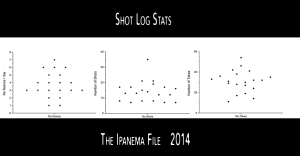When I first became involved with Fighting Badgers, one of the main things I did was spreadsheets. It’s a large part of my job as a research scientist, so it seemed a natural thing to do as the information started piling up. Contact details, scheduling information, script breakdowns… it was all there, colour coded, formatted, and gorgeous – I can’t say how glad we were for them when it did come time to start scheduling for The Ipanema File – not having the resources to use commercial scheduling software, having it all accessible by pivot table made it a lot less terrifying!
During the shoot, I was happy to take on the job of shotlogging – I knew from previous experience during the editing of Jagoda how vital accurate logs were, and as our editor was not present during the pre-production or shoot, I felt it was only fair to make things as straightforward as possible! Being on set is unpredictable – you can know the script and the shot list inside out, but sometimes the best laid plans gang agley, and things are dropped or changed, entire new shots, or even scenes can appear, and what you end up with at the end of the shoot may deviate in small but significant ways from the original script. If the editor, colour grader, or VFX person doesn’t have information on the film speed, lens, colour temperature, and any filters, it can be extremely difficult to get a consistent look to footage, and then there’s the sound – if using multiple mics, not having accurate logs of what came from where can make syncing a total nightmare! Being a total novice, all this I just transferred from my day job – if you don’t record every parameter of an experiment, how can you interpret the results??
I took this all pretty seriously, and have some badass spreadsheets to show for it. Being accustomed to playing with data in spreadsheet form, I was curious what all these logs would show up… essentially, what can we learn from shotlogs?
So I started with how many takes – that seemed most simple as each line in a log represents a take. How many takes did we do during the 3 week shoot? What was the average, and what influenced how many takes we did each day?
Over 20 days of filming, we took a total of 619 takes, averaging 31.0 takes per day, ranging from 11 to 54. For 95% of the shoot, the number of takes was within the range of 25.9-36.0.
The next thing I looked at was shots – a shot being one of multiple camera angles using during the filming of one scene, e.g. close-up, over the shoulder, point of view etc. I didn’t note down shots during the shoot, but could work out in most cases from the ‘additional information’ notes and the lens used – a different shot often required a lens change. The total number of shots was 287, with an average of 14.3 per day… meaning on average we tookjust over 2 takes for each shot, which was possible because, as was the saying on set: “Performances are saving us”.
The number of scenes per day made the most regular graph (as you can see below) – it was the only factor I looked at that we had actually planned in advance and it shows! The total number of scenes in the script was 82, giving us an average of 4.6 per day for the shoot duration we planned for – after all the changes that inevitably happened on set, we ended up shooting 75 scenes, over 20 days, giving a true average of 3.9, which isn’t too far off.
We did do a fair amount of pre-planning – the original script had 82 scenes… we shot 75; the original shot-log had 269 shots planned… we ended up with 287. Looking at a comparison of what we planned and what we did, it’s nice to see we weren’t far off… (at least I doubt the difference would be significant).
I also had a wee look at the most used lenses, and our top 3 was:
- 28mm (131 takes)
- 35mm (123 takes)
- 20mm (103 takes)
There are a few more things I’d like to do with this data, such as look more closely at shot/take ratio for types of locations, when we were most productive (time of day), what the most used filter was, how the number of actors involved influences the take/shot/scene outcome… but at the moment, I have a thesis (still) to write, so it will have to wait til I can justify all that messing about…
Would love to hear thoughts on this – I had a wee look and couldn’t find much on this, so please do leave a comment if you feel inclined!

